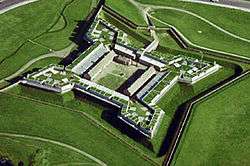John Stanwix
John Stanwix (born about 1690, England; died at sea, 29 October 1766) was a British soldier and politician.
He was born John Roos, the son of Rev. John Roos, rector of Widmerpool, Nottinghamshire. In 1725 he succeeded to the estates of his uncle Thomas Stanwix, MP and adopted the name of Stanwix.
Stanwix entered the army in 1706, rose to a captain of the grenadiers in 1739, major of marines in 1741, and lieutenant-colonel in 1745, and was appointed equerry to Frederick, Prince of Wales, in 1749. In 1750, he was appointed Governor of Carlisle, and also represented the town in the British parliament as the Member of Parliament for Carlisle (1741–42 and 1746–61).
In 1754, he became deputy quartermaster-general of the forces, and on 1 January 1756, he was made colonel-commandant of the 1st battalion of the 60th or Royal American Regiment. On his arrival in America he was given the command of the southern district. During 1757 his headquarters were at Carlisle, Pennsylvania, and he was appointed brigadier-general on 27 December of that year.

After his relief by General John Forbes in 1758, General Stanwix went to Albany, New York, whence he was ordered to the Oneida carrying-place, to secure that important position by the erection of a work which was called Fort Stanwix in his honor. In 1759 he returned to Pennsylvania, built and named Fort Pitt, and surmounted the works with cannon. He worked with George Croghan, the deputy superintendent of Indian affairs, to secure the good will of the Indians.
On 19 June 1759, Stanwix was appointed major-general, but he was relieved by General Robert Monckton on 4 May 1760, and became lieutenant-general on 19 January 1761. After his return to England he was appointed lieutenant-governor of the Isle of Wight and made colonel successively of the 49th Regiment of Foot (1761–1764) and the 8th (The King's) Regiment of Foot (1764–1766).
He was also Member of Parliament for Appleby in Westmorland from 1761 to 1766.
He was lost at sea while crossing from Dublin, Ireland, to Holyhead, Wales, in a packet boat The Eagle.
External links
- John Stanwix at the Probert Encyclopedia
- John Brooke, STANWIX, John (1693-1766), of Carlisle, Cumb. at The History of Parliament
- Romney R. Sedgwick, STANWIX, John (1693-1766), of Carlisle, Cumb. at The History of Parliament
| Parliament of Great Britain | ||
|---|---|---|
| Preceded by Charles Howard John Hylton |
Member of Parliament for Carlisle 1741–1742 With: Charles Howard |
Succeeded by Charles Howard John Hylton |
| Preceded by Charles Howard John Hylton |
Member of Parliament for Carlisle 1746–1761 With: Charles Howard |
Succeeded by Raby Vane Henry Curwen |
| Preceded by Philip Honywood Fletcher Norton |
Member of Parliament for Appleby 1761–1767 With: Philip Honywood |
Succeeded by Philip Honywood Charles Jenkinson |
| Military offices | ||
| Preceded by Sir Charles Howard |
Governor of Carlisle 1752–1763 |
Succeeded by The Earl of Darlington |
| Preceded by John Barrington |
Colonel of the 8th (The King's) Regiment of Foot 1764–1766 |
Succeeded by Daniel Webb |
| Preceded by George Walsh |
Colonel of the 49th Regiment of Foot 1761–1764 |
Succeeded by David Graeme |